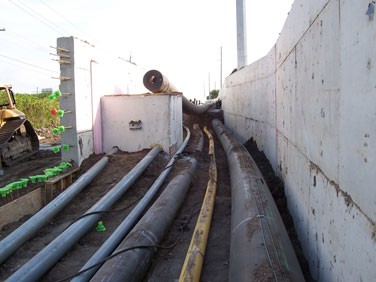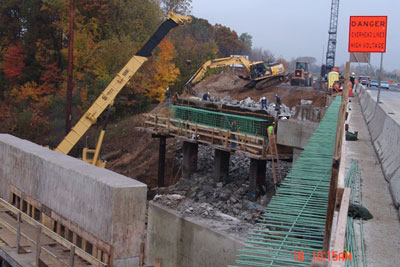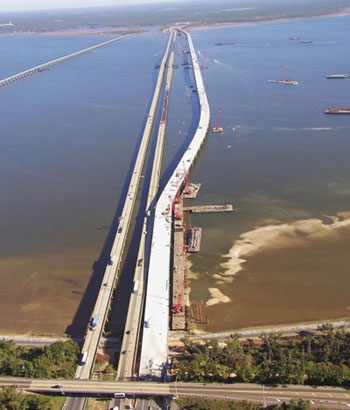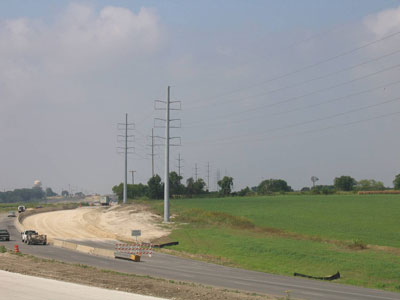U.S. Department of Transportation
Federal Highway Administration
1200 New Jersey Avenue, SE
Washington, DC 20590
202-366-4000
Focus
| Accelerating Infrastructure Innovations |
Publication Number: FHWA-HRT-07-014
Date: June 2007
The Federal Highway Administration's (FHWA) 2007 Excellence in Utility Relocation and Accommodation Awards recognize outstanding innovations that have significantly advanced how transportation agencies relocate or accommodate utilities on surface transportation improvement projects.
This year's winners demonstrate best practices in the following five categories: Incentives for Utility Relocation, Innovation, Project Management, Leadership, and Outstanding Individual Contributions. The categories recognize projects costing $100 million or less and projects over $100 million. Award recipients were honored April 30 at the 2007 American Association of State Highway and Transportation Officials' (AASHTO) Subcommittee on Right-of-Way and Utilities annual meeting in Orlando, Florida. For more information about the awards program, contact Jon Obenberger in FHWA's Office of Program Administration, 202-366-2221 (email: jon.obenberger@fhwa.dot.gov).
Incentives for Utility Relocation
Links I Utility Corridor, Florida
This project relocated the utility facilities for 12 companies in advance of the reconstruction of State Road 60 in Tampa, Florida. A 3-m (10-ft) wide by 3-m (10-ft) deep structure was built to house the 12 utilities. The utilities are stacked vertically, with staggered horizontal placement. A service road that also serves as a recreational trail was constructed on top of the utility structure. The construction of the utility corridor reduced the project duration from 7 to 5 years.
Award Recipients and Contacts:
Florida Department of Transportation, Dwayne Kile (dwayne.kile@dot.fl.us); City of Tampa, Chris Barquin (chris.barquin@tampagov.net); Ash Engineering, Inc., Janice Ash (jash@ashengineering.com)
Innovation
I-96 Superstructure Replacement Over Mid-MI Railroad, Michigan
The Michigan Department of Transportation (MDOT) had to contend with a dangerous work environment and a tight budget when replacing a bridge on I-96 that is located over a railroad line and below an active aerial electric transmission line. "Ensuring worker and public safety became a main challenge while working with heavy construction equipment in very close proximity to the high voltage and high demand electric transmission wires situated directly over the bridge piers," says Michael Lamancusa, Utility and Permit Engineer at MDOT. The agency achieved significant cost savings-and limited traffic disruptions and environmental disturbances along I-96-as a result of special safety provisions designed into the project and the use of an electronic sensing device and alarm attached to an operating crane. This innovation was proposed by the contractor, Walter Toebe Construction Company of Wixom, Michigan. The sensing device and alarm allowed construction to occur around the active utility line, versus having to relocate the line in order to complete the project.
Award Recipients and Contacts:
MDOT, Mike Lamancusa (Lamancusam@michigan.gov) or Rob Beckon (Beckonrd@michigan.gov); Walter Toebe Construction Co., David Frogner (dfrogner@toebe-construction.com); Michigan Electric Transmission Company, Erin Keeler (ekeeler@itctransco.com)
Project Management
Peachtree Boulevard Project and Subsurface Utility Engineering (SUE), Georgia
Peachtree Boulevard in downtown Atlanta, Georgia, is a densely populated roadway with numerous businesses located along it and heavy traffic. A recent reconstruction of a 0.67-km (0.42-mi) stretch of the roadway resulted in wider sidewalks, a tree-lined median, bike lanes, improved drainage, transit stops, and improved intersections. To aid in the reconstruction, the Georgia Department of Transportation (GDOT) used SUE to identify, verify, map, and coordinate the adjustment or relocation of 14,630 m (48,000 ft) of utility facilities for 10 different companies with active and abandoned facilities in the existing right-of-way.
Award Recipients and Contacts:
GDOT, Jeff Baker (jeff.baker@dot.state.ga.us); So-Deep, Inc., Thomas Rock (trock@sodeep.com)
Leadership
Avoiding Utility Project Impacts Training Program, Georgia
A new training program initiated by GDOT, "Avoiding Utility Project Impacts," provides designers and project managers with the necessary tools to reduce highway project delays by identifying and resolving potential utility conflicts early in the planning and design processes. The program incorporates state-of-the-art methods and technologies and encourages creative solutions when handling utility relocation and accommodation issues.
Award Recipients and Contacts:
GDOT, Jeff Baker (jeff.baker@dot.state.ga.us) or Brent D'Angelo (brent.dangelo@dot.state.ga.us); TBE Group, Inc., Mark Pitchford (mpitchford@tbegroup.com)
 |
| Florida's Links I Utility Corridor project built a structure to house the utility facilities for 12 companies. |
 |
| The Michigan Department of Transportation used an electronic sensing device and alarm attached to a crane to replace a bridge on I-96 located below an active power line. |
The Intercounty Connector (ICC), Maryland
As part of five design-build contracts to construct the ICC highway in the Washington, DC, suburbs, the Maryland State Highway Administration (MSHA) provided attractive incentives to 15 utility companies to relocate approximately $40 million of complex overhead and underground utility facilities. "This is the largest project MSHA has ever undertaken and it's the first to integrate electric and telephone utility relocation work into the design-build contract," says Nelson Smith, MSHA's Statewide Utility Engineer. To accomplish the project's aggressive schedule, MSHA agreed to pay 100 percent of the utility relocation costs for each utility company. By offering a significant monetary incentive to the utility companies, MSHA created a win/win situation for all of the ICC stakeholders.
Award Recipients and Contacts:
MSHA, Nelson Smith (nsmith@sha.state.md.us); ICC Corridor Partners, Jeff Ziegenfuss (jeffz@wtbco.com); TBE Group, Inc., Joseph Bissett (jbissett@tbegroup.com)
Innovation
State Highway 130 Toll Road Utility Adjustments, Texas
The award recognizes the Texas Department of Transportation (TxDOT) for creating a toll road "Developer Managed" model to accomplish utility adjustments and relocations on design-build projects. The model was developed for TxDOT's 79-km (49-mi) State Highway 130 Toll Road project, which involved 52 utility companies and more than 650 utility adjustments. "The main challenge of this project was simply the sheer magnitude of it all," says John Breed of TxDOT's Turnpike Authority Division. "We were working with over 50 utility companies and we wanted to get information about the project to those companies as soon as possible." To carry out the utility adjustments, TxDOT's toll road developer had to determine which utility facilities were good candidates for a developer-managed type of adjustment. "In the end, the key to the success of this project was in building a spirit of cooperation among all those involved," says Breed.
Award Recipients and Contacts:
Texas Turnpike Authority, Don Toner (dtoner@dot.state.tx.us); TxDOT, John Breed (jbreed@dot.state.tx.us); Surveying & Mapping, Inc., H. Scott Colter (scolter@saminc.biz)
Project Management
Replacement of I-10 Bridges over Escambia Bay, Florida
Severely damaged by Hurricane Ivan in September 2004, the I-10 bridges over Escambia Bay in the western panhandle of Florida were in need of major reconstruction. In April 2005, the Florida Department of Transportation (FDOT) awarded a $245 million design-build contract to construct a new bridge over the 4.8-km (3-mi) Bay. FDOT partnered with utility companies to relocate or adjust their facilities in advance of the fast-track project. As a result, the utility facilities were relocated within 6 months of the project notification, reducing the project's overall cost and construction time.
Award Recipients and Contacts:
FDOT, Robert Ellis (robert.ellis@dot.state.fl.us); TBE Group, Inc., Vincennes LaVallette (vlavallette@tbegroup.com); Parsons Brinckerhoff Quade & Douglas, John Poulson (poulson@pbworld.com); Tidewater-Skanska/Flatiron JV, Paul Rudloff (ptrudloff@tidewaterskanska.com)
Leadership
Minnesota State Trunk Highway 212 Design-Build Project, Minnesota
The award honors the accomplishments of the Minnesota Department of Transportation's (Mn/DOT) Utility Task Force. The task force was set up to coordinate utility relocations for the construction of a 19-km (12-mi) freeway on a new alignment. Close coordination and communication among Mn/DOT, construction staff, and utility owners was essential to accomplishing the project and ensuring efficient and high-quality work.
Award Recipients and Contacts:
Mn/DOT, John Chiglo (jon.chiglo@dot.state.mn.us); Zumbro River Constructors, Scott Risley (scott.risley@fluor.com)
This award was presented to Paul Scott of TBE Group, Inc. Since 2003, Scott has served as the TBE Group's National Utilities Liaison. Prior to that, his 33-year career at FHWA included coordinating national utility regulations and policies and promoting the use of SUE. Scott also serves as Chair of the Transportation Research Board Utilities Committee and Vice-Chair of the American Society of Civil Engineers committee that prepares the standard guidelines for collecting and depicting subsurface utility data.
 |
| The Florida Department of Transportation partnered with utility companies to relocate or adjust their facilities before the fast-track construction of the Escambia Bridge. |
 |
| The Texas Department of Transportation's State Highway 130 Toll Road project involved 52 utility companies and more than 650 utility adjustments. |